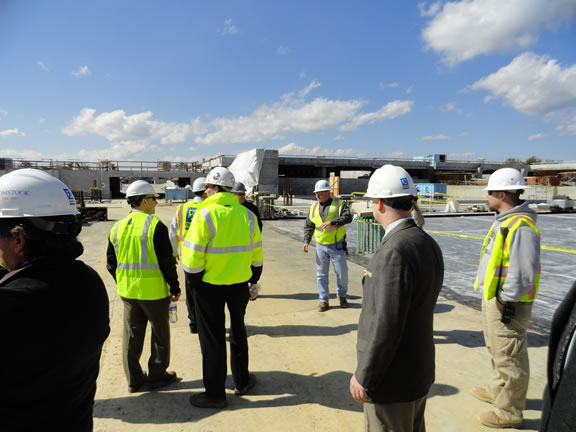Based upon the WBC Regional Development Committee’s monthly tours of some of the region's more ambitious developments, one would have no idea that we’re emerging from the worse recession since the 1930s. It sure helps to be a builder in this region.
Thanks to coordination by WBC committee member Barb Smith of Barbara J. Architectural Sales, Clark Construction Senior Project Manager Brian Naumick provided a thorough overview of the challenges and approaches to the coming-out-of-the-ground Science and Engineering Hall. Listen to this: a $275 million, 570,000 sf, 4 parking levels and 2 program levels below ground, 8 stories above ground, state-of-the-art flexible learning and research space, 4,000 sf of retail on a constrained site adjacent to the Foggy Bottom Metro Station and active GW dormitories. Yes, WMATA’s Adjacency Construction Standards apply as well. Then there is DC DOT, rock blasting, multiple shoring and construction styles, such as shoulder piling & tie back, tandem pile walls and cross lots. The construction ramps required 2/3rd of the site and had to be reconfigured at one point to reach the 80 depth of the lowest level. As Mr. Naumick put, “There aren’t any easy areas in this job. BIM makes all the difference in the world.”, referring to the use of computer modeling software not only during the design and construction document phases, but also for coordination during construction.
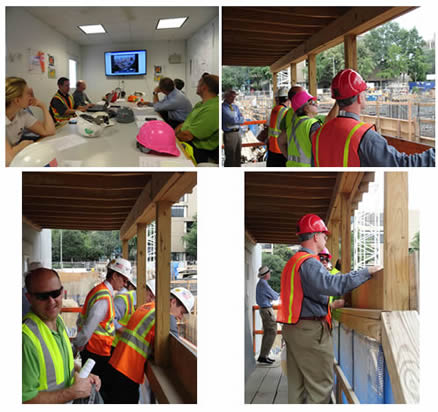
The Science and Engineering Hall connects to an existing building across the street via three below-grade tunnels, constructed with the street remaining operational. This other building is also being upgraded and will serve in part as a co-generation facility for the Hall and other buildings on campus. Significant features of the project interior finishes include a reliance on architectural glass to divide program areas (instead of traditional gyp. board partitions) plus custom-fabricated portable workstations, which were a major factor in space planning and utility terminal device location for the laboratories and work spaces. The exterior will feature large expanses of glass and a unique terra cotta cladding system fabricated in Germany.
Project schedulers and the project managers earn their salt when it comes to such complexity. Started in 2011 with a 42 month delivery scheduled in 2014, the construction schedule is some 12 months longer than for a similar green field project. The pressure remains high as the University looks for the Science and Engineering Hall as a place making hub with a LEED Gold rating and the Clark Enterprises Inc. Chair and CEO is a major benefactor to the GW Engineering School. Thanks to construction team work, Mr. Naumick proudly states, “We are on schedule.”
About the Author
 Rob Klein is currently Manager of Development Programs for Montgomery County’s Department of General Services. He has over 30 years of development experience. In August, Rob will be starting his own consulting business. He holds degrees in City Planning and Economics.
Rob Klein is currently Manager of Development Programs for Montgomery County’s Department of General Services. He has over 30 years of development experience. In August, Rob will be starting his own consulting business. He holds degrees in City Planning and Economics.
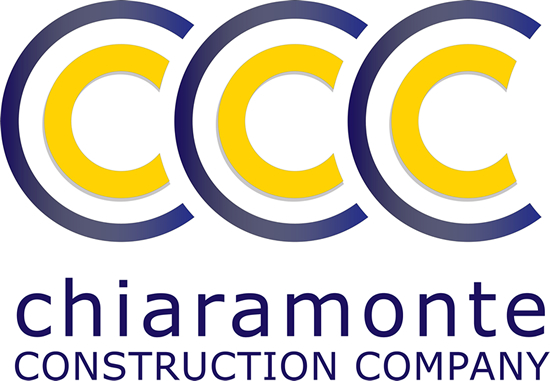




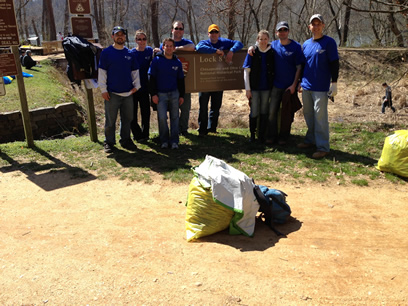
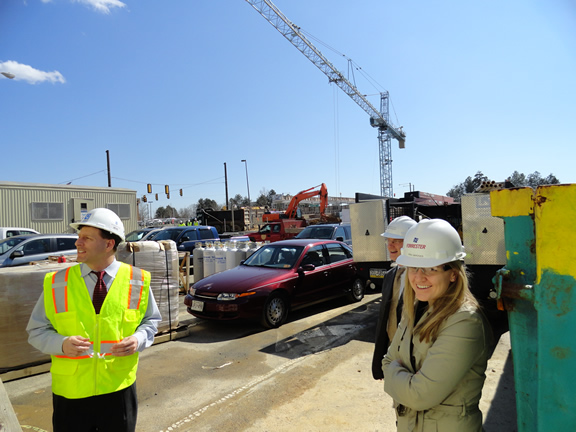
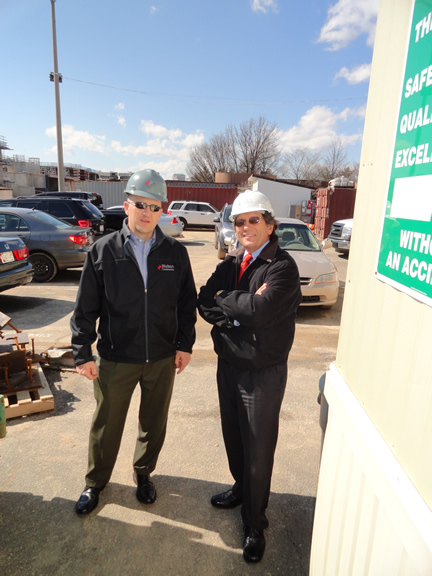 In return for the developing the transit station Comstock has development rights, through a 99 year lease allowing for 1.5 million square feet, which will include 100,000SF of retail, three office buildings, a 22-story, 448 unit apartment building opening in 2015, a 200 plus room hotel, all surrounding an urban civic plaza. As part of the planning process the citizens of Reston demanded that the architecture be iconic and the developer has responded by hiring internationally renowned architect Helmut Jahn to design the largest building a 530,000SF, twenty-story, trophy office building that will sit on the site’s most prominent corner, Weihle Avenue and the Dulles Toll Road.
In return for the developing the transit station Comstock has development rights, through a 99 year lease allowing for 1.5 million square feet, which will include 100,000SF of retail, three office buildings, a 22-story, 448 unit apartment building opening in 2015, a 200 plus room hotel, all surrounding an urban civic plaza. As part of the planning process the citizens of Reston demanded that the architecture be iconic and the developer has responded by hiring internationally renowned architect Helmut Jahn to design the largest building a 530,000SF, twenty-story, trophy office building that will sit on the site’s most prominent corner, Weihle Avenue and the Dulles Toll Road. 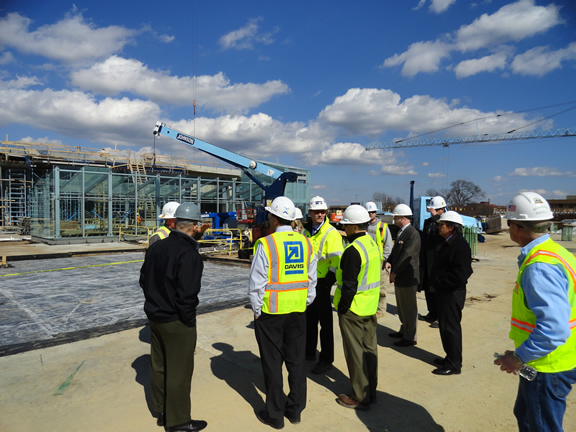 Following the briefing, which was held at Comstock’s nearby office, the committee moved to the job site and started the tour on what will be the plaza. While two cranes remain on the site, facilitating the remaining heavy lifts, crews are currently placing brick pavers on the concrete deck which will provide a path from the garage stairs/elevators to the metro access walk-ways which span the west bound lanes of the Dulles Toll and Access Roads. Below the plaza level, we toured the bus terminal with its nearby escalators, as well as dropping several levels below to see a nearly finished, enormous, parking level. The committee learned of a few amazing project stats while on the tour. The below grade parking facility required the removal of over 650,000 cubic yards of dirt, placement of 89,350 yards of concrete reinforced with 18.8 million pounds of steel. Columns in the parking garage if lined up end to end would stretch 6 miles. The demand for concrete was so great that the site required two batch plants, that while allowing for quality control, were needed to be supplemented by delivery of ready mix from off of the site. Concrete placed on site actually totaled more than used for the construction of Chicago’s Willis Tower (formerly the Sears Tower).
Following the briefing, which was held at Comstock’s nearby office, the committee moved to the job site and started the tour on what will be the plaza. While two cranes remain on the site, facilitating the remaining heavy lifts, crews are currently placing brick pavers on the concrete deck which will provide a path from the garage stairs/elevators to the metro access walk-ways which span the west bound lanes of the Dulles Toll and Access Roads. Below the plaza level, we toured the bus terminal with its nearby escalators, as well as dropping several levels below to see a nearly finished, enormous, parking level. The committee learned of a few amazing project stats while on the tour. The below grade parking facility required the removal of over 650,000 cubic yards of dirt, placement of 89,350 yards of concrete reinforced with 18.8 million pounds of steel. Columns in the parking garage if lined up end to end would stretch 6 miles. The demand for concrete was so great that the site required two batch plants, that while allowing for quality control, were needed to be supplemented by delivery of ready mix from off of the site. Concrete placed on site actually totaled more than used for the construction of Chicago’s Willis Tower (formerly the Sears Tower).